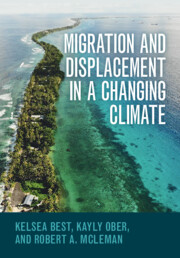Refine search
Actions for selected content:
134 results
6 - To Flee or to Fight
-
- Book:
- The Venal Origins of Development in Spanish America
- Published online:
- 11 October 2025
- Print publication:
- 02 October 2025, pp 124-159
-
- Chapter
- Export citation
7 - Nakba: The Displacement of the Medical Community
-
- Book:
- Palestinian Doctors
- Published online:
- 12 September 2025
- Print publication:
- 02 October 2025, pp 214-247
-
- Chapter
- Export citation
The Archive of Displacement: Vernacular History and Urban Cemeteries in Oran, Algeria
-
- Journal:
- Comparative Studies in Society and History , First View
- Published online by Cambridge University Press:
- 26 September 2025, pp. 1-28
-
- Article
-
- You have access
- Open access
- HTML
- Export citation
Becoming a Muhacir: Writings and Narratives of Displacement in the Late Ottoman Empire
-
- Journal:
- International Journal of Middle East Studies , First View
- Published online by Cambridge University Press:
- 25 September 2025, pp. 1-20
-
- Article
-
- You have access
- Open access
- HTML
- Export citation
Trust perception in Syrian refugee children
-
- Journal:
- Development and Psychopathology , First View
- Published online by Cambridge University Press:
- 10 September 2025, pp. 1-12
-
- Article
-
- You have access
- Open access
- HTML
- Export citation
4 - Who Is Most at Risk?
-
- Book:
- From Crisis to Action
- Published online:
- 15 August 2025
- Print publication:
- 04 September 2025, pp 74-92
-
- Chapter
-
- You have access
- Open access
- HTML
- Export citation
Forecasting displacement and solutions for decision-making in volatile contexts: a case study from Ukraine
- Part of
-
- Journal:
- Data & Policy / Volume 7 / 2025
- Published online by Cambridge University Press:
- 06 August 2025, e55
-
- Article
-
- You have access
- Open access
- HTML
- Export citation
Death of the Gharīb: A Window towards a Regional Understanding of Displacement in the Middle East
-
- Journal:
- Comparative Studies in Society and History / Volume 67 / Issue 4 / October 2025
- Published online by Cambridge University Press:
- 17 July 2025, pp. 761-784
-
- Article
-
- You have access
- Open access
- HTML
- Export citation
8 - Electromagnetism in Matter
-
- Book:
- Electromagnetism
- Published online:
- 26 June 2025
- Print publication:
- 19 June 2025, pp 273-336
-
- Chapter
- Export citation
Voice as Constellation: Listening to the Voices and Silences of Displacement in Three Acts
-
- Journal:
- Royal Musical Association Research Chronicle ,
- Published online by Cambridge University Press:
- 28 May 2025, pp. 1-12
-
- Article
-
- You have access
- Open access
- HTML
- Export citation
4 - Migration and Displacement Risks Associated with Mean Sea Level Rise
-
- Book:
- Migration and Displacement in a Changing Climate
- Published online:
- 10 April 2025
- Print publication:
- 17 April 2025, pp 131-161
-
- Chapter
- Export citation
1 - People on the Move in a Changing Climate
-
- Book:
- Migration and Displacement in a Changing Climate
- Published online:
- 10 April 2025
- Print publication:
- 17 April 2025, pp 1-50
-
- Chapter
- Export citation
3 - Migration and Displacement Associated with Aridity, Drought, Heat, and Wildfires
-
- Book:
- Migration and Displacement in a Changing Climate
- Published online:
- 10 April 2025
- Print publication:
- 17 April 2025, pp 95-130
-
- Chapter
- Export citation
2 - Migration and Displacement Associated with Extreme Weather Events
-
- Book:
- Migration and Displacement in a Changing Climate
- Published online:
- 10 April 2025
- Print publication:
- 17 April 2025, pp 51-94
-
- Chapter
- Export citation

Migration and Displacement in a Changing Climate
-
- Published online:
- 10 April 2025
- Print publication:
- 17 April 2025
Altruism, Ethnic Identity, and the Limits of Shared Hardship
-
- Journal:
- Journal of Race, Ethnicity and Politics , First View
- Published online by Cambridge University Press:
- 21 March 2025, pp. 1-23
-
- Article
-
- You have access
- Open access
- HTML
- Export citation
22 - Refugee health nursing
- from Part IV - Community and primary health care roles
-
-
- Book:
- An Introduction to Community and Primary Health Care
- Published online:
- 27 March 2025
- Print publication:
- 20 March 2025, pp 333-345
-
- Chapter
- Export citation
Learning Forced Migration: Guidance for Prospective Jewish Refugees in Nazi Germany
-
- Journal:
- Central European History / Volume 58 / Issue 1 / March 2025
- Published online by Cambridge University Press:
- 13 March 2025, pp. 25-45
- Print publication:
- March 2025
-
- Article
-
- You have access
- Open access
- HTML
- Export citation
Introduction
-
- Book:
- New Sudans
- Published online:
- 06 February 2025
- Print publication:
- 13 February 2025, pp 1-28
-
- Chapter
- Export citation
The longitudinal relationship between psychological symptoms and social functioning in displaced refugees
-
- Journal:
- Psychological Medicine / Volume 55 / 2025
- Published online by Cambridge University Press:
- 12 February 2025, e40
-
- Article
-
- You have access
- Open access
- HTML
- Export citation
